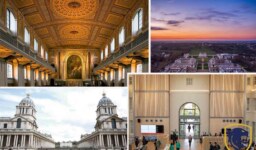From the 12th through the 16th century, Gothic architecture predominated in European architecture. The Gothic Style developed gradually from the older Romanesque style, with a focus on France, England, Spain, and Germany. In addition to this, Gothic Style architecture is characterized by several features, including pointed arches, Rose Windows, Flying Buttresses, and stained glass. Despite the fact that religious complexes made up the majority of the most remarkable Gothic constructions, other examples of the style include palaces, castles, and governmental structures.
Chartres Cathedral
There is no doubt that the Chartres Cathedral has been one of the most well-known examples of European Gothic architecture from the 12th and 13th centuries. To formally house the Bishop of Chartres, the Roman Catholic Church constructed the cathedral. The Chartres Cathedral is located in Chartres. It is a city in central France about north of Paris. Also, it is one of the most spectacular architectural creations in France from any era and a significant historical landmark in this region.

Buildings With Best Gothic Architecture; Chartres Cathedral
As far as we know, the construction of the Chartres Cathedral took place between 1194 and 1120 AD. The cathedral’s interior and façade have undergone various redesign and improvement work since it completed its construction. But its ribbed underlying architecture has been mainly preserved. The cathedral’s interior has just undergone extensive maintenance, which makes it look much more spectacular to those within its walls. There can only be one cathedral that can rival the Chartres Cathedral as being the pinnacle of Gothic architecture.
Notre Dame
One of the best examples of the French Gothic architectural style is the Notre Dame Cathedral. This architectural masterpiece is situated on the Île de la Cité in Paris, France. As one of the oldest Gothic cathedrals, it has seen several important historical occasions, including the beatification of Joan of Arc and Napoleon Bonaparte’s coronation.
It was the first to use certain well-known Gothic architectural features. Those gothic features include the flying buttress and ribbed ceiling, which today characterize the design. While several of the structures on the list were built when Gothic and Renaissance architecture coexisted, this edifice was created as Gothic architecture was on the rise. Also, it incorporates elements of previous Romanesque architecture.

Notre Dame
There are many reasons why Notre Dame is as famous as it is, including Victor Hugo’s book The Hunchback of Notre Dame. The belltower where the main character of the book formerly resided is now a popular tourist destination. It is accessible by ascending a 387-step, very narrow stairway.
With an estimated 12 million visitors a year, the cathedral is also the most visited landmark in Paris. Unfortunately, after a terrible fire in April 2019, visitation to the building has been permanently halted. The goal of the 2021 reconstruction project is to have Notre Dame ready for the 2024 Summer Olympics in Paris.
The Cologne Cathedral
The Archbishop of Cologne is based in the city’s enormous Gothic cathedral. The construction of the complete building lasted over 600 years. After starting in 1248, the project was abandoned in 1473. Later, in the 1840s the resumption of construction was started. Also, according to the original designs, it was finished in 1880. The biggest Gothic cathedral in Northern Europe is the Cologne Cathedral. Additionally, it boasts the second-tallest spires constructed fully in the Germanic Gothic design.

Buildings With Best Gothic Architecture; The Cologne Cathedral
It took many bomb strikes during World War II, which seriously destroyed it. The Cologne collapsed around it. But despite the devastation, it was mostly preserved. In March 1945, it also experienced a tank fight between German and American units. The cathedral had substantial repairs following the war, which are still ongoing.
Milan Cathedral
The fourth biggest church in the world, the Milan Cathedral commemorates the birth of St. Mary. It is defined as a combination of several architectural styles, sometimes with respect and other times with contempt. Considering that building lasted from 1386 to 1965, this is to be anticipated. The biggest change in architectural design took place when preferences started to move from classic Gothic to more modern Renaissance concepts. Renaissance concepts were not always easily incorporated. Also, elements of the Gothic and neo-Gothic styles frequently reappear in the building.
Simone de Orsenigo, an Italian architect and engineer, intended the new church to be built in the Lombard Gothic style, which frequently utilized bricks. However, Nicolas de Bonaventure, a French architect, reconstructed the building in the French Rayonnant Gothic style because he thought it was a more appropriate style.

Milan Cathedral
Construction paused and resumed over the course of several years. There were several redesigns that ranged in style from the Italian Renaissance through the Baroque and back to Gothic. Some of these elements, like the Baroque façade, even made a comeback in Gothic architecture.
Many people are not persuaded of the cathedral’s authenticity or beauty, despite many features returning to the original Gothic’s goal. It was reportedly described by Oscar Wilde as “The Cathedral is a terrible disaster. According to him, the outside design is hideous and uncreative. Everything about it is disgusting; but, due to its size and an intricate execution, it is intimidating and colossal as a failure. The overly complex elements are put up high where no one can see them.
Reims Cathedral
The Reims Cathedral, which is situated in the ancient city of Reims, France, is another of the most well-known Gothic churches in the world. The name Notre-Dame de Reims, which means “Our Lady of Reims” in English, is the official name of the structure. The cathedral was a church that had been formally consecrated to the Virgin Mary upon its completion. Moreover, it features a long list of Gothic architectural features. The crowning of French kings has historically taken place in the Reims Cathedral.

Buildings With Best Gothic Architecture; Reims Cathedral
The Reims Cathedral’s current building was first built in 1211 AD. However, the enormous cathedral was constructed on the site of a previous church that is believed to have been erected in the fifth century A.D. Further, it was probably started by Bishop Nicasius somewhere around the year 425 A.D. This cathedral is renowned for both the numerous ancient artworks housed within its walls and the ornate front-facing front.
Canterbury Cathedral
One of England’s oldest cathedrals in Canterbury. Its lengthy history dates back to the sixth century. Between 1070 and 1077, this church was constructed to resolve a long-standing disagreement between the two men. After a fire 100 years later, the east end was once more reconstructed in the English Gothic architectural style.

Canterbury Cathedral
The current design of Canterbury Cathedral, which replaced its previous Norman nave and transepts, comes mostly from the 14th century. The assassination of Archbishop Tomas Becket was arguably the most significant historical incident to occur in Canterbury. The two men had a protracted disagreement. So, Henry II dispatched his knights to resolve it. In 1988, UNESCO designated it a World Heritage Site




